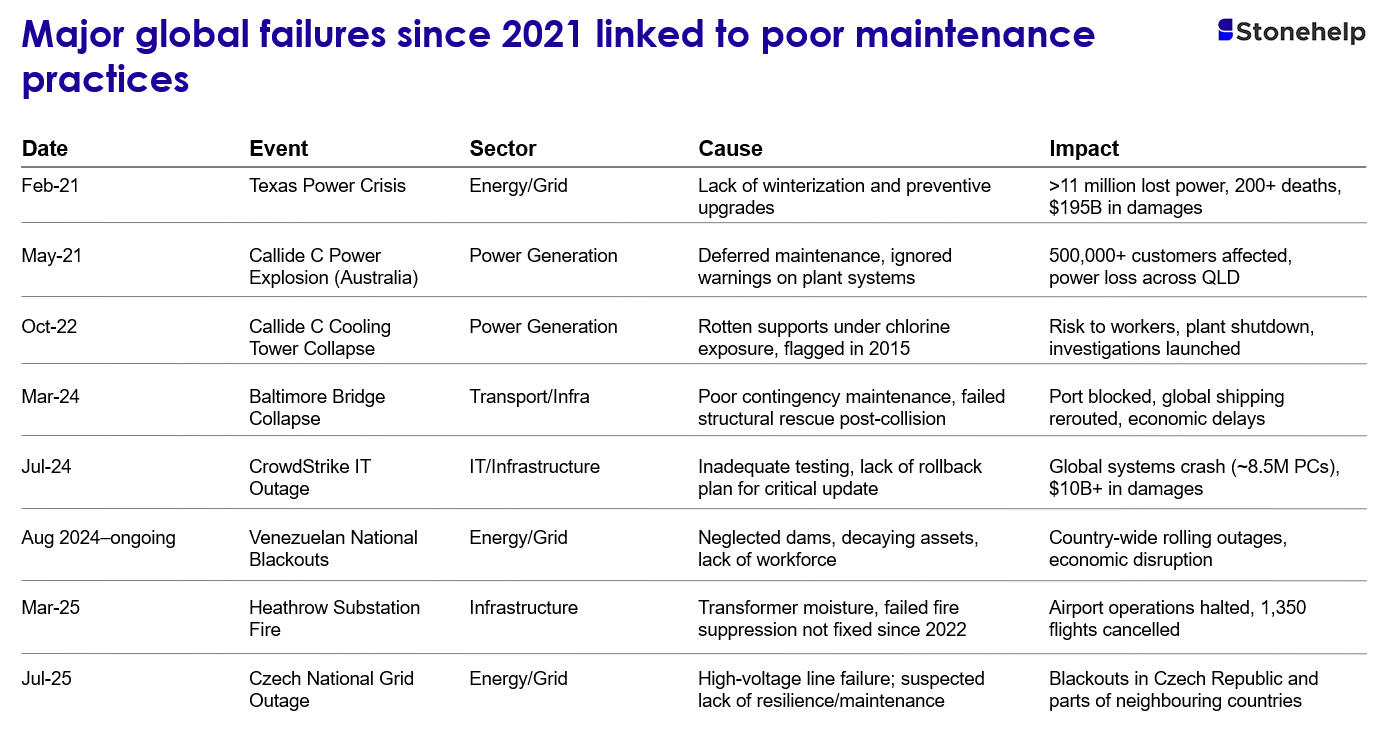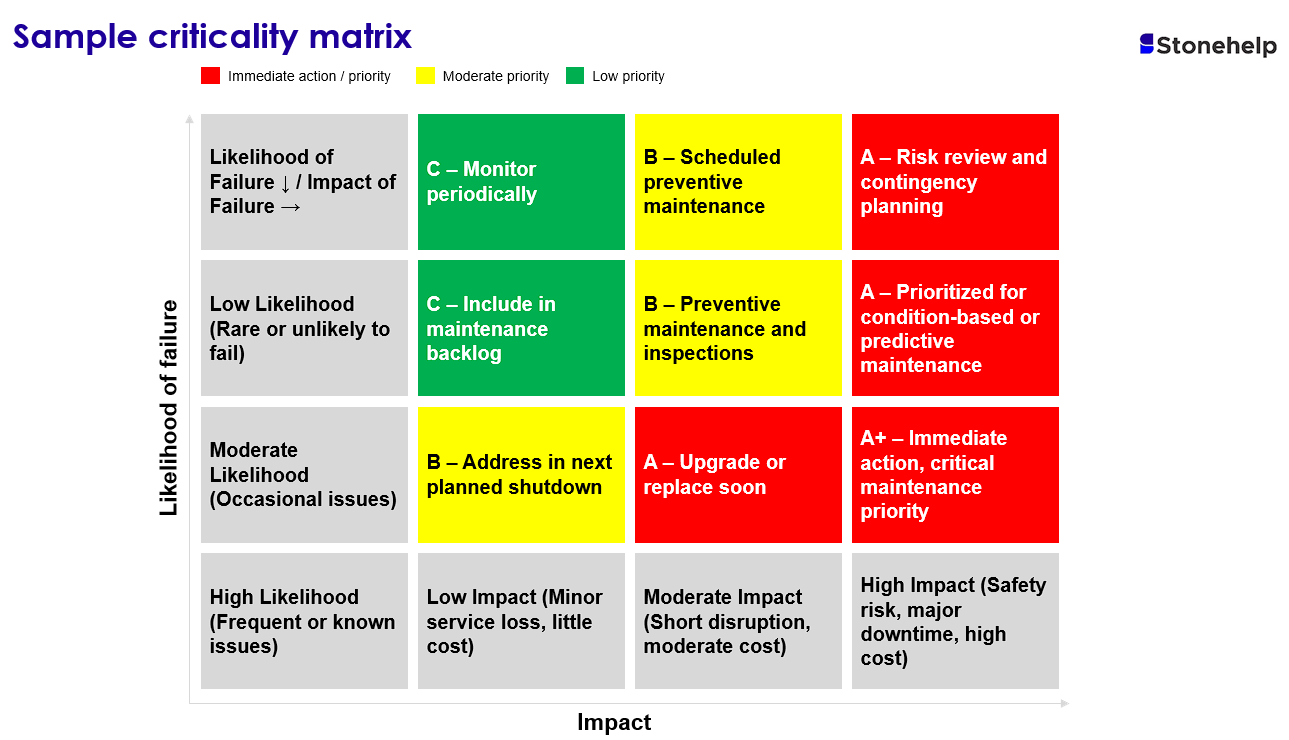
When the Grid Went Dark
In February 2021, a powerful winter storm struck Texas, plunging over four and a half million homes and businesses into darkness. The catastrophe was not simply about freezing temperatures. It exposed deep weaknesses in infrastructure and maintenance practices. Critical energy assets such as natural gas compressors and turbines failed because they were not adequately prepared or maintained for extreme cold. A report from the Federal Energy Regulatory Commission (FERC) later identified insufficient winterization and overlooked maintenance routines as significant contributors to the grid’s collapse. This incident illustrates a painful truth: the lack of a robust, proactive maintenance strategy can lead to large-scale failure.
Such failures are far from isolated incidents. From the Texas power crisis and Australian plant explosions to global IT outages and collapsing infrastructure, the past few years have shown how costly poor maintenance can be. Across sectors, organizations continue to lose time, resources, and even lives to breakdowns that could have been prevented. This often happens in systems that are considered only “moderately critical.” These events are not rare. They reflect deeper gaps in how maintenance is managed. The way forward starts with strong asset criticality assessments, better preventive and predictive maintenance, using digital tools for real-time insights, and building a culture of operational discipline at every level

Here’s how leaders can build the foundations of long-term plant reliability:
1. Start with Criticality Assessment: Focus on Assets that Truly Matters
Long-term reliability begins by identifying which assets carry the most significant consequences if they fail. Asset criticality assessments evaluate safety impact, production disruption, cost implications, and environmental risks. Rather than treating all equipment equally, organizations must prioritize assets based on these risk factors.
Leaders who apply this approach can focus their maintenance resources where they are most needed. This ensures that high-risk equipment receives proactive attention while less critical assets do not drain time and budget. It improves overall plant reliability, enhances safety, and increases the return on investment in maintenance operations.

2. Optimize Preventive Maintenance: Less Work Can Deliver Better Results
Research shows that between 40 and 60% of preventive maintenance tasks provide minimal value and don’t significantly improve uptime. Many maintenance routines persist simply because they are traditional or required by regulation, not because they effectively prevent failure. Optimization involves using tools like Reliability-Centered Maintenance, failure reporting systems, and structured reviews of existing routines. These methods help teams design preventive maintenance programs based on real-world failure modes. The goal is not to do more maintenance but to perform the right maintenance at the right time. This reduces unnecessary labor, minimizes costs, and improves equipment health.
3. Leverage Digital Work Management: Integrate and Improve Efficiency
Digital Work Management systems are transforming how maintenance teams operate by centralising planning, execution, and reporting. When integrated with enterprise platforms like ERP or CMMS and enhanced with mobile or augmented reality tools, these systems allow real-time visibility into work orders, asset health, and technician progress. The result is not just improved coordination, but a step change in how decisions are made, moving from reactive scheduling to data-informed, proactive prioritisation.
McKinsey research shows that digital work systems can increase productivity by up to 30 percent and cut unplanned downtime by nearly a third. One global chemical manufacturer deployed a bolt-on solution connected to its ERP and, within five weeks, improved planning efficiency by 30 percent and doubled on-time completion. These results are not anomalies. They reflect what becomes possible when operational clarity replaces ambiguity.
Digital systems eliminate paper-based bottlenecks, streamline communication, and guide technicians through standardised tasks with visual instructions and live updates. This not only reduces confusion and wasted motion, but empowers frontline teams to focus on value adding maintenance. The shift is not just about speed. It is about building precision, accountability, and discipline into every step of the maintenance lifecycle.
4. Instill Operational Discipline: Build a Culture of Reliability
Tools alone do not drive reliability. True maintenance excellence begins with a culture of discipline, precision, and accountability. As DuPont Sustainable Solutions defines it, operational discipline means doing each task the right way, every time, based on proven methods. This culture is shaped by strong leadership, peer expectations, and a shared belief that small actions prevent major failures. When this mindset is in place, tools help reinforce consistency. Without it, even the best systems cannot deliver results.
Leading teams use tools like Maximo for workflow standardisation, Prism by Uptake for real-time equipment alerts, and Mobility Work to track frontline inputs. These support habits of consistency, accountability, and safety. When technicians act on signals like vibration, corrosion, or heat loss early, they prevent costly downtime and build long-term operational resilience grounded in behavioural excellence.
5. Plan Strategically: Embed Resilience into Every Layer
Maintenance must be designed as a system, not just a checklist. Leaders should create strategies that are adaptable, focused, and data-informed. This involves:
- Conducting regular asset criticality assessments to direct maintenance where it matters.
- Using data and engineering insights to eliminate unnecessary tasks and optimize frequency.
- Implementing digital platforms that connect work planning, scheduling, and tracking.
- Reinforcing discipline through training, standard procedures, and consistent supervision.
- Tracking key metrics such as maintenance backlog, planned work completion, and the ratio of corrective to preventive tasks.
This approach ensures the maintenance program remains aligned with business needs, regardless of changes in staffing, equipment, or budget constraints.
Building a Future-Proof Maintenance System
Achieving reliable operations is not a one-time project. It is an ongoing journey that demands attention, structure, and leadership. Organizations that prioritize critical assets, streamline preventive work, adopt digital tools, and foster a disciplined culture consistently outperform those that rely on reactive approaches.
After experiencing a major equipment failure, Henri and her team restructured their entire maintenance approach. The failed component was recategorized, preventive schedules were adjusted, and a digital work platform was introduced. As a result, turbine breakdowns dropped by more than 70 percent within a few months. Their success was not just in fixing a problem but in preventing future ones through a thoughtful, sustained strategy.
Maintenance is not just a technical function. It is a strategic asset. When done right, it protects people, improves efficiency, and strengthens the bottom line.